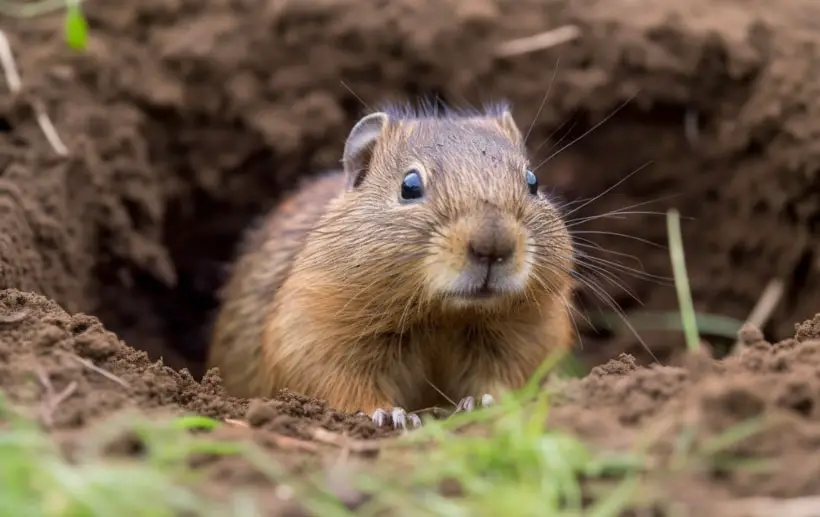How to Collapse Gopher Tunnels
Gophers are burrowing rodents that can cause severe damage to lawns, gardens, and agricultural land. So how to collapse gopher tunnels might be one of the questions in your head.
To manage these animals effectively, it is essential to have a good understanding of their behavior and tunneling habits. Every farmer must know how to effectively collapse gopher tunnels using various techniques.
Besides, it’s important to get an overview of gopher behavior and tunneling habits and the different types of gopher traps available to use. Also, you need to learn other methods of control, such as repellents and exclusion techniques.
The article will provide step-by-step instructions on collapsing these backyard pests’ tunnels using different techniques. One essential aspect of the process is locating the main tunnels.
Let’s explore the use of water and gas to collapse tunnels and the potential risks and benefits associated with each method.
Understanding Gopher Tunnels: The Impact on Lawns and Gardens
These small burrowing rodents are mainly found in many parts of North America. Let’s explore the various types of gopher tunnels, how to identify them, and how they can impact your plants and lawns.

Overview of Gopher Tunneling Habits
Gophers are known for their extensive tunneling systems ranging from a few feet to hundreds of feet in length. They create mainly two kinds of tunnels: surface tunnels and deep tunnels.
1. Surface Tunnels
They are created close to the surface of the soil and are used for feeding and foraging. The mounds of dirt that the gopher burrows push up can be used to identify them since they are often short and shallow.

2. Deeper Tunnels
Deeper tunnels are made and used for nesting and transportation. These tunnels may span great distances and reach depths of many feet. The absence of dirt mounds on the surface typically identifies them.
Identifying Different Types of Gopher Tunnels
Gophers are known for their intricate tunnel systems, which are essential for their survival. Depending on their needs, they build various types of tunnels. In this discussion, we will explore the different types of tunnels and how to identify them.

Main Tunnels
The main tunnels are the primary passageways that gophers use for travel and foraging. These tunnels can be located at varying depths, ranging from a few inches to several feet underground. To locate the main tunnels, look for crescent-shaped dirt mounds with a plug of dirt on one side.
Lateral Tunnels
In addition to the main tunnels, gophers also build lateral tunnels. These tunnels are used for storage and can be identified by the presence of food caching.
Emergency Escape Tunnels
Gophers also build emergency escape tunnels as a last resort in case of danger. These tunnels are shorter and straighter than the main tunnels and often have a closed surface to the ground. To identify them, look for tiny holes that are visible on the soil’s surface.
How Gopher Tunnels Affect Plants and Lawns
Gopher tunnels can have detrimental effects on both plants and lawns. These furry rodents disrupt plant roots when they burrow into the ground, causing stunted growth, wilting, and even death in severe cases. Additionally, they may consume plant roots, exacerbating the damage.

Moreover, gopher tunnels can be hazardous for lawns due to their uneven surfaces, which pose tripping hazards. The dirt mounds that gopher excavation can produce can also mar the appearance of lawns and gardens.
Collapsing Gopher Tunnels: Effective Methods and Pros/Cons
Many gardeners and homeowners look for techniques to destroy tunnels and stop additional harm. The best ways to collapse gopher tunnels are covered here. These are discussed along with their advantages and disadvantages and comparisons to other rodent management techniques:

1. Flooding
Flooding is a typical technique for causing gopher tunnels to collapse. It involves flooding the area surrounding tunnels, which may result in the collapse of the tunnels. Because they require dry Soil types to thrive and will leave wet tunnels, this technique is frequently successful.
The lawn or garden pests can be completely submerged in water or flooded with a hose. It is crucial to remember that in places with high water tables or exceptionally deep soil, flooding may not be effective.
Benefits
- Flooding is a non-toxic technique that doesn’t impact surrounding species
- It is a cheap choice that doesn’t call for any specific equipment
Cons
- Flooding may not be successful in places with high water tables or all types of soil
- It may also take a lot of time and require many applications to be successful
2. Gas Cartridges
Another technique for collapsing gopher tunnels using gas cartridges. They let out poisonous gas into the tunnels, usually aluminum phosphide or carbon monoxide. This can kill gophers and cause the tunnels to collapse.
Typically, to seal in the gas, gas cartridges are positioned in the tunnels and then covered with earth. Professional gopher control or pest control companies frequently utilize this technique, but households may also buy it.
Benefits
- Gas cartridges can usually kill gopher species rapidly and are often successful
- They also take little work and are often simple to operate
Cons
- If not used properly, gas cartridges might poison other creatures
- They may also be costly and call for several applications
3. Gopher Bombs
Another method for destroying tunnels is to use gopher explosives. These resemble gas cartridges, but instead of releasing gas into the tunnels, they drop a smoke bomb.
Gopher tunnels may collapse and be destroyed by the smoke of these predators. Often, bombs are planted in the tunnels and then covered with dirt to keep the smoke within.
Benefits
- Gopher bombs are available at many garden supply stores and are frequently effective
- They also take little work and are often simple to operate
Cons
- Gopher bombs can be toxic and can harm other wildlife if not used properly
- They can also be expensive and may require multiple applications
Comparison to Other Rodent Control Methods
Two further popular techniques for managing gophers and other rodents are Trapping and Exclusion. Trapping regulations is the process of putting traps below or above ground to catch gophers.
Exclusion is using fences or other barriers for prevention. As a result, it restricts gophers from accessing particular areas, such as gardens or lawns.
Benefits
- Trapping and exclusion are safe techniques that don’t affect other creatures
- They can also be rather inexpensive solutions and are frequently successful
Cons
- Trapping and exclusion need more work than other techniques and might fail in pest control
- They could need regular monitoring and might also be time-consuming
Effective Measures to Preventing Gopher Damage to Lawns
Gophers can cause significant harm to your lawn, garden damage, and landscaping by damaging plants, trees, and irrigation systems. However, you can minimize their impact by taking several preventative measures.

- Planting Gopher-Resistant Plants
One way to preventing gopher damage to gardens is to plant species that gophers are less likely to eat. Some of these plants may be poisonous or unappealing to them, such as castor beans, daffodils, or foxglove.
Other options include planting prickly or tough foliage plants like yucca, rosemary, or agave, which gophers are less likely to dig through.
- Maintaining a Healthy Lawn
Another effective measure to preventing gopher damage to lawns is to keep your lawn healthy. Gophers are attracted to dry and dead grass, so regularly watering and fertilizing your lawn can discourage them from tunneling.
Additionally, mowing your lawn regularly can also prevent gophers from creating burrows. Thus, lower lawn damage.
Impact of Preventative Measures on Gopher Species Behavior
Preventative measures can discourage gophers from invading your property as an effective gopher control. By creating a less favorable environment for them by planting gopher-resistant plants or maintaining a healthy lawn, you can deter them from damaging your plants.

Comparison to Other Rodent Control Methods
While trapping, poisoning, or using sonic repellents may provide immediate results, these methods can harm other wildlife removal or have unintended consequences. In contrast, preventative measures are a natural and sustainable solution that does not rely on harmful chemicals or traps.
If you’re looking for effective ways to collapse gopher tunnels, our article on how to collapse gopher tunnels provides a variety of methods for controlling gopher populations. Additionally, if you’re interested in the difference between gophers and beavers, our article on gopher vs beaver explores the distinguishing characteristics and behaviors of these two rodents. Finally, if you’re trying to identify whether you have ground squirrels or gophers in your yard, our article on ground squirrel vs gopher provides information on how to tell these two rodents apart. Our piece on gopher vs beaver provides insights into the differences between these two rodents, while our article on ground squirrel vs gopher provides guidance on distinguishing between these two common yard pests.FAQs
Let’s look at some commonly asked questions people ask related to collapsing gopher tunnels:
Q: Can Gophers Cause Damage To Pipes And Other Underground Structures?
Indeed, gophers may destroy pipelines and other subterranean infrastructure by tunneling and digging, which can cause structural damage and soil erosion. Further damaging them, they could gnaw on pipelines and wires buried beneath.
Q: How Deep Do Gophers Tunnel?
In search of food and refuge, gophers normally burrow systems 6 to 12 inches below the surface, although they are capable of going as far as 6 feet.
Q: How Long Do Gophers Live?
Gophers can live up to three years in the wild, but they can live even longer in captivity.
Conclusion
Maintaining the health of lawns, gardens, and agricultural land requires controlling gophers. Understanding gopher behavior and tunneling behaviors is essential for how to collapse gopher tunnels. This also includes identifying several gopher tunnel kinds and their effects on gardens and lawns.
Effective anticipation and grass maintenance depend on having a thorough understanding of gopher behavior and tunneling patterns. Plant and grass damage from gopher tunnels might include disturbed plant roots, stunted growth, wilting, and trip hazards.
Future studies should concentrate on creating environmentally safe and more techniques that don’t hurt other animals. Overall, for successful pest control and grass maintenance, it is essential to comprehend gopher behavior and tunneling activities.




